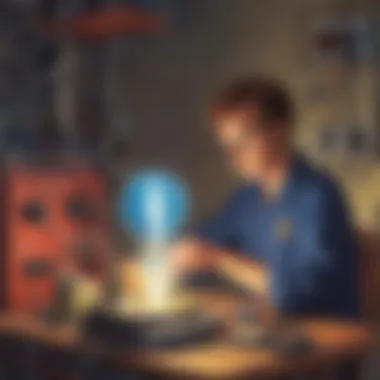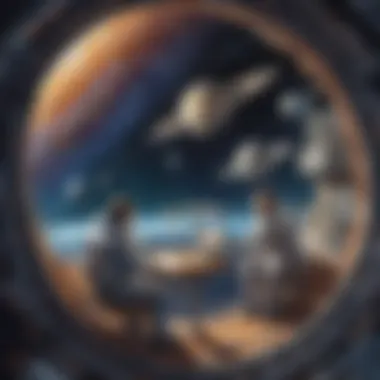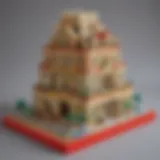Unleashing Curiosity: Science Experiments to Amaze Young Minds


Science Fun Facts
Lab Littles' fascination with science goes beyond standard lessons, offering intriguing trivia and facts that illuminate the wonders of the natural world. From quirky science stories that challenge conventional thinking to astounding science records that defy expectations, LabLittles enriches young minds with an array of engaging curiosities. Prepare for thought-provoking questions that encourage exploration and critical thinking, paving the way for a deeper understanding of scientific phenomena.
Discover the Wonders of Science
Embark on a journey through the captivating realm of science on Lab Littles, where various scientific concepts come to life through interactive learning tools. Dive into educational videos and animations that simplify complex ideas, making them accessible and enjoyable for young learners. Discover the real-life applications of science, bridging the gap between theoretical knowledge and practical relevance, empowering children to see science in action.
Science Quiz Time
Engage in captivating interactive quizzes on Lab Littles, designed to test knowledge, spark curiosity, and enhance learning through gamification. Tackle multiple-choice questions that challenge reasoning and problem-solving skills. Delve into brain teasers and puzzles that encourage analytical thinking and creativity, fostering a dynamic and entertaining environment for enriching scientific knowledge.
Science Experiment Showcase
Unleash the thrill of scientific exploration with Lab Littles' showcase of fun and engaging experiments that captivate and educate. Follow detailed step-by-step instructions that guide aspiring young scientists through each experiment seamlessly. Access a comprehensive materials list to ensure smooth execution and delve into essential safety tips and precautions that prioritize a secure and enriching scientific journey.
Introduction
Exploring Science Experiments: Inspiring Young Minds on Lab Littles Portal initiates a profound journey into the realm of science exploration for young enthusiasts aged 6-12. This article aims to delve into the captivating world of scientific experiments, offering a gateway to exciting discoveries and educational insights on the LabLittles platform. By highlighting the importance of hands-on experimentation at a young age, this section sets the stage for a stimulating and enriching learning experience for children.
Understanding Science Experiments
Definition and Importance
Delving into the essence of Definition and Importance in the context of science experiments reveals a crucial foundation for young minds embarking on scientific exploration. This aspect serves as a cornerstone in cultivating a deep understanding of scientific concepts, fostering critical thinking skills, and nurturing a passion for discovery. The fundamental characteristic of Definition and Importance lies in its ability to engage young learners in tactile learning experiences, offering a hands-on approach to comprehending complex scientific phenomena. This interactive and immersive learning method enriches the educational journey on the Lab Littles portal, stimulating curiosity and enhancing retention of scientific knowledge.
Types of Science Experiments
Exploring the diverse landscape of Types of Science Experiments provides a multifaceted approach to learning and experimentation on Lab Littles. These experiments encompass a wide range of disciplines, including chemistry, physics, and biology, catering to varied interests and curiosities of young learners. The key characteristic of Types of Science Experiments lies in their versatility and applicability, offering interactive and engaging activities that cater to different learning styles. By integrating hands-on projects, observations, and data analysis, these experiments foster a holistic understanding of scientific principles, encouraging young minds to explore, question, and innovate within the realm of science.
Lab
Littles: A Hub for Science Enthusiasts
Brief Overview


An insightful exploration of the Brief Overview underscores the pivotal role of Lab Littles as a premier platform for young science enthusiasts. This overview provides a comprehensive introduction to the vibrant ecosystem of educational resources, experiments, and interactive content available on the portal. Drawing young learners into a world of discovery and knowledge dissemination, LabLittles' Brief Overview sets the tone for a stimulating and enriching educational experience. The unique feature of LabLittles' Brief Overview lies in its seamless integration of fun and educational content, fostering a love for learning while sparking curiosity and creativity in young minds.
Mission and Vision
Unveiling the Mission and Vision of Lab Littles unveils the dedication and commitment of the platform to inspire, educate, and captivate young learners on their scientific journey. The inherent mission of LabLittles is to empower children with the tools and knowledge to explore the wonders of science with enthusiasm and curiosity. This vision encompasses a holistic approach to learning, incorporating fun, interactive experiences that ignite a lifelong passion for scientific discovery. By prioritizing hands-on learning, experimentation, and engagement, LabLittles' Mission and Vision aim to shape young minds into confident, inquisitive individuals eager to unlock the mysteries of the natural world.
Chemistry Experiments
Chemistry experiments play a crucial role in this article on exploring science experiments to inspire young minds on Lab Littles portal. By delving into the realm of chemical reactions and transformations, these experiments serve as engaging educational tools for children aged 6-12. Understanding chemistry concepts at a young age lays a solid foundation for future scientific curiosity and exploration. These experiments offer insights into the fascinating world of molecules and reactions, fostering analytical thinking and enhancing problem-solving skills.
Simple Chemical Reactions
Creating Volcanic Eruptions
Creating volcanic eruptions is a captivating experiment that simulates the explosive nature of a volcanic eruption. By combining everyday materials like baking soda and vinegar, this experiment vividly demonstrates the chemical reaction between an acid (vinegar) and a base (baking soda) which produces carbon dioxide gas and foamy eruptions. The key characteristic of creating volcanic eruptions lies in its dramatic visual impact, sparking immediate interest and engagement among young learners. This experiment's hands-on nature actively involves children in the scientific process, promoting experiential learning and critical observation skills. Despite its messiness, the excitement and educational value make creating volcanic eruptions a popular and beneficial choice for this article.
Rainbow Density Column
The rainbow density column experiment showcases the principles of density and fluid layering in a visually stunning display. By layering liquids of varying densities such as honey, dish soap, water, and vegetable oil, this experiment creates a colorful column where each liquid sits distinctively above the other based on its density. The unique feature of the rainbow density column lies in its ability to demonstrate dense and less dense liquids and their natural tendency to form distinct layers. This experiment offers a visually engaging way to introduce and understand the concept of density, making it an excellent choice for this article. While it requires careful layering and precision, the vibrant visual appeal and educational value of the rainbow density column outweigh any potential disadvantages.
Acid-Base Reactions
Invisible Ink
Invisible ink experiments present a creative and intriguing way to explore the concept of acid-base reactions while fostering a sense of mystery and fun. By using substances like lemon juice or baking soda solution as the 'ink,' children can write invisible messages that only become visible when exposed to heat or another chemical agent. The key characteristic of invisible ink lies in its transformative nature, where hidden messages magically appear through the chemical reaction between the ink and the 'revealing' agent. This experiment not only stimulates curiosity but also teaches the fundamental principles of acidity and basicity in a playful manner, making it a valuable addition to this article. Though it may require adult supervision and careful handling of heat sources, the excitement and intrigue of invisible ink experiments make them a popular and worthwhile choice.
Fizzing Experiments
Fizzing experiments provide an entertaining and interactive way to explore acid-base reactions through the generation of carbon dioxide gas and effervescent reactions. By combining baking soda with acids like vinegar or lemon juice, children can observe vigorous bubbling and fizzing, illustrating the chemical process at play. The key characteristic of fizzing experiments is the audible and visible reaction that occurs, sparking curiosity and wonder in young minds. This experiment's immediate and tangible results make it a popular choice for introducing chemical reactions, emphasizing hands-on learning and promoting scientific inquiry. While some care is needed to handle the reactive substances safely, the excitement and educational value of fizzing experiments outweigh any minor concerns.
Crystallization Projects
Borax Crystal Snowflakes
Borax crystal snowflakes offer a captivating blend of science and art, allowing children to witness crystal formation and symmetry in action. By making a supersaturated solution of borax and hot water, children can grow intricate crystal snowflakes on pipe cleaners suspended in the solution. The key characteristic of borax crystal snowflakes is the geometric precision and delicate beauty of the crystal structures that form, resembling frosty snowflakes. This experiment not only showcases the process of crystallization but also emphasizes patience and observation as the crystals slowly grow. The unique feature of borax crystal snowflakes lies in the hands-on experience of creating intricate crystal designs, making it a valuable choice for this article. While adult supervision is necessary for handling hot water and borax, the mesmerizing results and educational aspect of this experiment make it a popular and enriching option.


Sugar Crystal Lollipops
Sugar crystal lollipops combine science and culinary arts, allowing children to grow edible sugar crystals on wooden sticks. By dissolving sugar in hot water and allowing the solution to cool and crystalize on the sticks, children can witness the formation of sweet, crystalline treats. The key characteristic of sugar crystal lollipops is the dual enjoyment of conducting a science experiment while creating delicious candies. This experiment not only introduces the concept of crystal growth but also encourages creativity and exploration in the kitchen. The unique feature of sugar crystal lollipops lies in the combination of scientific principles with a tasty outcome, making it a delightful and educational choice for this article. While adult assistance may be needed for handling hot liquids, the joy of making and eating homemade lollipops enhances the overall learning experience and enjoyment for young participants.
Physics Experiments
Physics Experiments are a crucial component of this comprehensive guide on exploring science experiments on Lab Littles Portal. The study of physics enables young minds to grasp fundamental principles governing the universe, such as energy, motion, light, and magnetism. By engaging in physics experiments, children aged 6-12 can develop critical thinking skills, problem-solving abilities, and a deeper understanding of the natural world around them. These experiments aim to ignite curiosity, inspire a love for scientific exploration, and foster a lifelong passion for learning.
Energy and Motion
Balloon Rocket
Balloon Rocket experiments serve as an exciting introduction to the concepts of energy and motion. By inflating a balloon and releasing it, children observe how the escaping air propels the balloon forward. This hands-on activity actively demonstrates Newton's Third Law of Motion, showcasing action and reaction forces in a simple yet effective manner. The Balloon Rocket experiment not only entertains young learners but also educates them on essential physical principles.
Pendulum Painting
Pendulum Painting merges creativity with science, offering a unique exploration of motion and dynamics. By attaching paint-filled containers to a swinging pendulum, children witness mesmerizing patterns emerge as the pendulum moves. This experiment combines artistry with physics, allowing youngsters to see the relationship between pendulum motion and paint dispersion. Pendulum Painting encourages innovation, experimentation, and a deeper appreciation for the harmonious interplay between art and science.
Optics and Light
DIY Solar Oven
The DIY Solar Oven project immerses children in the principles of optics and solar energy utilization. By constructing a simple oven using reflective materials, kids harness the power of sunlight to cook snacks or conduct heat-based experiments. This experiment not only teaches about light reflection and absorption but also instills eco-friendly practices by utilizing renewable energy sources. The DIY Solar Oven empowers young minds to explore sustainable technology and encourages creative problem-solving.
Exploring Light Reflection
Exploring Light Reflection engages young learners in understanding how light behaves when it encounters different surfaces. By experimenting with mirrors, prisms, and everyday objects, children uncover the mysteries of reflection, refraction, and dispersion. This hands-on activity sparks curiosity about the properties of light, colors, and optics, fostering an interest in scientific inquiry and experimental exploration. Exploring Light Reflection cultivates a deeper understanding of how light interacts with the environment, prompting critical thinking and observation skills.
Electricity and Magnetism
Build a Simple Circuit
Building a Simple Circuit introduces children to the fundamental concepts of electricity and circuitry. By assembling basic circuits with batteries, wires, and lights, young minds learn about conducting paths, electrical flow, and switch mechanisms. This experiment not only demystifies electrical components but also encourages problem-solving and investigation into circuit behavior. Building a Simple Circuit empowers children to delve into the world of electronics, sparking curiosity in engineering and technological innovation.
Magnetic Slime Creation


Magnetic Slime Creation blends science with creativity, enabling kids to explore the principles of magnetism and polymer chemistry. By mixing common household ingredients with magnetic particles, children create a slime that responds to magnetic fields. This experiment not only introduces magnetic properties but also promotes tactile sensory exploration and material science understanding. Magnetic Slime Creation inspires playful discovery of magnetic forces and material interactions, nurturing a fascination for scientific experimentation and innovative material design.
Biology Experiments
As we delve into the realm of Biology Experiments, we uncover a fascinating world that holds immense importance in nurturing young minds on the Lab Littles portal. Exploring biological concepts through hands-on activities offers children a unique opportunity to understand the wonders of nature and the intricacies of living organisms. By engaging in Biology Experiments, children can develop a deeper appreciation for the environment, learn about the diversity of life forms, and grasp fundamental biological principles.
Botany Exploration
Within the vast spectrum of Biology Experiments, Botany Exploration emerges as a crucial subcategory that focuses on plant life and growth processes. This segment aims to introduce young learners to the fascinating world of plants, encouraging them to explore the various stages of plant growth and development. Through Botany Exploration, children can gain insight into the importance of plants in our ecosystem, the significance of photosynthesis, and the role of plants in sustaining life on Earth.
Germination in Action
One key aspect of Botany Exploration is 'Germination in Action,' a captivating experiment that unveils the magic of seed germination. This experiment allows children to witness the miraculous transformation of a seed into a seedling, fostering their understanding of germination cycles and the conditions necessary for plant growth. The experimentation with germination in action not only educates children about plant life cycles but also instills in them a sense of responsibility towards nurturing and caring for plants, enhancing their environmental awareness.
Seed Dissection
Another intriguing facet of Botany Exploration is 'Seed Dissection,' which enables young minds to explore the internal structures of seeds and comprehend their role in plant reproduction. Through seed dissection, children can observe firsthand the different parts of a seed, such as the embryo, cotyledon, and seed coat, gaining valuable insights into the anatomy of seeds. This hands-on activity promotes scientific inquiry and cultivates a curiosity for botanical studies, empowering children to deepen their knowledge of plant anatomy and reproduction mechanisms.
Conclusion
In the ever-evolving landscape of educational platforms, the conclusion of this article serves as a pivotal point encompassing the essence of Lab Littles' mission. Through a judicious blend of comprehensive content, engaging experiments, and interactive learning tools, LabLittles aims to kindle a sense of scientific curiosity among young minds. Not only does the conclusion emphasize the significance of hands-on learning, but it also underscores the profound impact of encouraging scientific exploration in fostering a love for discovery.
Inspiring Curiosity Through Experiments
Impact of Hands-On Learning
Delving into the domain of hands-on learning, the immersive experience it provides is unparalleled. By actively engaging children in practical experiments, hands-on learning cultivates a deeper understanding of scientific concepts. Its tactile nature allows young learners to connect theory with real-world applications, fostering a more profound comprehension of scientific principles. One of the key benefits of hands-on learning is its ability to enhance problem-solving skills and critical thinking capacities among children. Although it requires meticulous planning and supervision, the experiential knowledge gained through hands-on activities far outweighs its challenges.
Encouraging Scientific Exploration
Scientific exploration stands as a cornerstone of nurturing a child's inquisitive nature. By encouraging young minds to question, experiment, and analyze, the spirit of scientific exploration opens new avenues of discovery. In the context of this article, promoting scientific exploration serves to broaden children's horizons and instill a sense of wonder and curiosity about the natural world. The practical applications of scientific exploration not only boost a child's confidence but also hone their observational skills. While it demands a degree of structured guidance, the rewards of instilling a curiosity for scientific inquiry are immeasurable.
Unlocking the World of Science
Empowering Young Minds
Empowering young minds through exposure to scientific knowledge is paramount in shaping the future generation. By fostering an environment that nurtures curiosity and critical thinking, Lab Littles empowers children to question, explore, and innovate. Through interactive experiments and educational resources, LabLittles equips young learners with the tools necessary to navigate the complexities of the scientific realm confidently. The emphasis on empowering young minds lies in igniting a passion for learning and discovery that transcends traditional boundaries.
Fostering a Love for Discovery
At the heart of Lab Littles' mission lies the commitment to fostering a profound love for discovery within children. By providing a platform enriched with scientific experiments and exploratory activities, LabLittles cultivates a sense of curiosity and wonder in young minds. The interactive nature of the portal fosters a hands-on approach to learning, instilling a lifelong appreciation for the marvels of science. While fostering a love for discovery demands patience and dedication, the rewards of witnessing a child's newfound passion for exploration are truly priceless.







